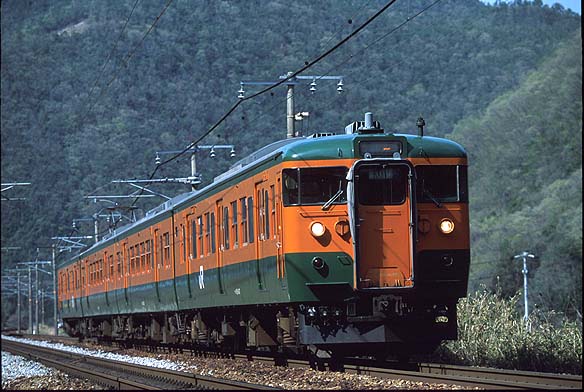Background and overview
Some 115 series vehicles used in Hiroshima and Okayama regions were relocated to Kansai area to unify special rapid and rapid services in Kansai area into 3-door vehicles in 1991. Accordingly, JR West modified some 117 series intermediate vehicles into 115 series intermediate vehicles and classified them into 115-3500 series in 1992.
Car body
They have 2900mm wide body. Their body design incorporates lightweight shaped steel and pressed forming beam to realize a lightweight body. They are equipped with two 1300mm wide double-leaf automatic sliding doors. 4 pairs of 715mm wide double-hung unit assembled side windows, the upper sash of which moves down and the lower moves up, and door case windows are fitted between the doors, and a pair of 715mm wide double-hung unit assembled windows and a door case window are fitted at either end of the body. Door operating equipments, TK8A, allowing hand operation to prevent the passenger's room from being cold in winter are fitted on the door header of the sliding doors. A destination rollsign adopted for 115 series is prepared to be fitted on each side of the body. Air-conditioned sets are equipped with an air conditioner, AU75B, rated at 42000kcal/h on the centre of the roof. Electric powered intake fan units are fitted on both side of the air conditioner and no ventilators on the roof. Vehicles allocated at Okayama depot are applied livery which is green with orange wide band around side windows. On the other hand, vehicles allocated at Shimonoseki depot are applied livery which is cream with blue narrow band below side windows.
Bogies
Bogies are DT32H featuring pedestal type journal supporting system, the diaphragm air spring and the large diameter centre pivot. Their bogies also employ the single tread brake rigging.
Traction unit and ancillary equipments
Eight series-wound brushed DC traction motors, MT54D, with a power output
of 120kW are controlled by the armature-resistance traction control system,
CS43A, fitted to powered intermediate vehicles, class moha115-3500. CS43A
features holding breaking and free selectable speed control. Class moha114-3500
vehicles are equipped with a motor generator, MH135-DM92, with a power
output of 160kVA and a motor driven air compressor, MH113B-C2000M, under
the floor. Class moha115-3500 vehicles are also equipped with a current
pickup, PS16J, on the roof. Jumper couplers are replaced to fit 115 series.
They adopt electromagnetic straight air brake with the rheostatic brake.
Accommodation
3 rows of switchable transverse seating immediately inside the doors were converted to longitudinal bench seating to increase the capacity of the cars and make boarding and alighting easier. Straps are additionally fitted above the longitudinal seating. The electricity for fluorescent light of the passenger salon is changed from 254VAC to 100VAC.
Modification and refurbishment
Life extension programme N30
JR West commenced life extension programme N30 on 24 115-3000 series vehicles to reduce the cost of the refurbishment programme N40 over the period from August 2004 until November 2008.
Car body
Corroded body skin was refurbished ventilators on the roof were removed. The buttons beside the door were additionally fitted to open or close the door manually by pushing them. Side windows, double leaf sliding doors, and the door operating equipments were not refurbished. The method to equip door case windows and the windscreen with the windowpane was changed into gluing.
Accommodation
The covers fitted on the floor for the inspection of the traction motor were filled with the plates. Doors located at both ends of the vehicle were changed into self-closing.
Operations
JR West delivered 115-3500 series intermediate vehicles to Okayama depot to compensate that 115-1000 series intermediate vehicles consisted 4-car sets were relocated for JR Kobe, JR Kyoto, and Biwako lines rapid services in 1992. They entered Sanyo, Ako, and Hakubi lines local services. However, 115-3500 vehicles were displaced with surplus 115-1000 series intermediated vehicles displaced with 227 series EMUs which were delivered to Hiroshima depot over the period from April 2015 until June 2016. Eventually 115-3500 series allocated at Okayama depot were completely scrapped.
On the other hand, JR West 115-3500 series intermediate vehicles to Shimonoseki depot to displace 115-0 series intermediate vehicles working with 115-3000 series end vehicles in 1992 and entered local and rapid services in Hiroshima region. JR West commenced life extension programme N30 on 115-3000 series with new livery. Subsequently they were repainted into yellow monochromatic colour in 2012. Rapid services were also discontinued at this time.
Nevertheless, 115-3500 series vehicles were withdrawn from local services of Iwakuni and eastward in 2016 since 227 series EMUs were delivered for the local services in Hiroshima area from 2014. They are now used on Sanyo line rural services between Iwakuni and Shimonoseki. |
|



